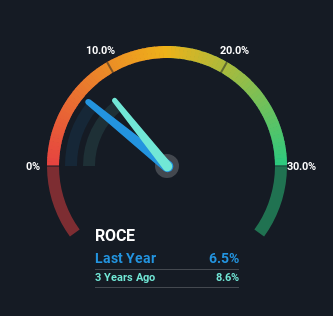Investors Could Be Concerned With Port of Tauranga's (NZSE:POT) Returns On Capital
If we want to find a potential multi-bagger, often there are underlying trends that can provide clues. In a perfect world, we'd like to see a company investing more capital into its business and ideally the returns earned from that capital are also increasing. Put simply, these types of businesses are compounding machines, meaning they are continually reinvesting their earnings at ever-higher rates of return. However, after investigating Port of Tauranga (NZSE:POT), we don't think it's current trends fit the mold of a multi-bagger.
What Is Return On Capital Employed (ROCE)?
For those who don't know, ROCE is a measure of a company's yearly pre-tax profit (its return), relative to the capital employed in the business. The formula for this calculation on Port of Tauranga is:
Return on Capital Employed = Earnings Before Interest and Tax (EBIT) ÷ (Total Assets - Current Liabilities)
0.065 = NZ$170m ÷ (NZ$2.8b - NZ$221m) (Based on the trailing twelve months to June 2023).
Therefore, Port of Tauranga has an ROCE of 6.5%. In absolute terms, that's a low return, but it's much better than the Infrastructure industry average of 3.8%.
View our latest analysis for Port of Tauranga
Above you can see how the current ROCE for Port of Tauranga compares to its prior returns on capital, but there's only so much you can tell from the past. If you'd like to see what analysts are forecasting going forward, you should check out our free report for Port of Tauranga.
The Trend Of ROCE
When we looked at the ROCE trend at Port of Tauranga, we didn't gain much confidence. Over the last five years, returns on capital have decreased to 6.5% from 9.6% five years ago. However, given capital employed and revenue have both increased it appears that the business is currently pursuing growth, at the consequence of short term returns. If these investments prove successful, this can bode very well for long term stock performance.
On a related note, Port of Tauranga has decreased its current liabilities to 7.8% of total assets. So we could link some of this to the decrease in ROCE. What's more, this can reduce some aspects of risk to the business because now the company's suppliers or short-term creditors are funding less of its operations. Some would claim this reduces the business' efficiency at generating ROCE since it is now funding more of the operations with its own money.
The Bottom Line On Port of Tauranga's ROCE
Even though returns on capital have fallen in the short term, we find it promising that revenue and capital employed have both increased for Port of Tauranga. In light of this, the stock has only gained 22% over the last five years. Therefore we'd recommend looking further into this stock to confirm if it has the makings of a good investment.
If you're still interested in Port of Tauranga it's worth checking out our FREE intrinsic value approximation to see if it's trading at an attractive price in other respects.
For those who like to invest in solid companies, check out this free list of companies with solid balance sheets and high returns on equity.
Have feedback on this article? Concerned about the content? Get in touch with us directly. Alternatively, email editorial-team (at) simplywallst.com.
This article by Simply Wall St is general in nature. We provide commentary based on historical data and analyst forecasts only using an unbiased methodology and our articles are not intended to be financial advice. It does not constitute a recommendation to buy or sell any stock, and does not take account of your objectives, or your financial situation. We aim to bring you long-term focused analysis driven by fundamental data. Note that our analysis may not factor in the latest price-sensitive company announcements or qualitative material. Simply Wall St has no position in any stocks mentioned.

 Yahoo Finance
Yahoo Finance 
